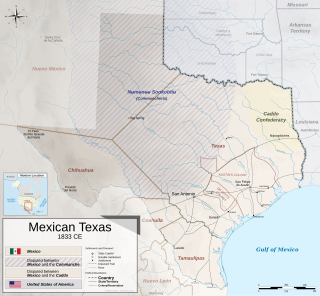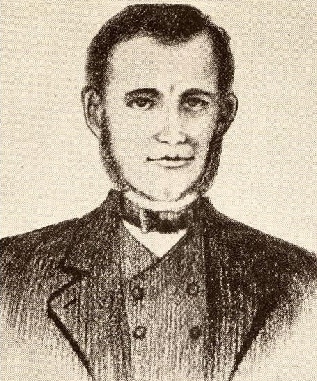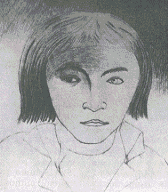
The Republic of Texas was a sovereign state in North America that existed from March 2, 1836, to February 19, 1846. It shared borders with Mexico, the Republic of the Rio Grande, and the United States of America.

The Texas Revolution was a rebellion of colonists from the United States and Tejanos against the centralist government of Mexico in the Mexican state of Coahuila y Tejas. Although the uprising was part of a larger one, the Mexican Federalist War, that included other provinces opposed to the regime of President Antonio López de Santa Anna, the Mexican government believed the United States had instigated the Texas insurrection with the goal of annexation. The Mexican Congress passed the Tornel Decree, declaring that any foreigners fighting against Mexican troops "will be deemed pirates and dealt with as such, being citizens of no nation presently at war with the Republic and fighting under no recognized flag". Only the province of Texas succeeded in breaking with Mexico, establishing the Republic of Texas. It was eventually annexed by the United States.

Jean Lafitte was a French pirate and privateer who operated in the Gulf of Mexico in the early 19th century. He and his older brother Pierre spelled their last name Laffite, but English language documents of the time used "Lafitte". This has become the common spelling in the United States, including places named after him.

James Bowie was a 19th-century American pioneer, slave smuggler and trader, and soldier who played a prominent role in the Texas Revolution. He was among the Americans who died at the Battle of the Alamo. Stories of him as a fighter and frontiersman, both real and fictitious, have made him a legendary figure in Texas history and a folk hero of American culture.

David Gouverneur Burnet was an early politician within the Republic of Texas, serving as the interim president of Texas in 1836, the second vice president of the Republic of Texas (1839–1841), and the secretary of State (1846) for the new state of Texas after it was annexed to the United States.

The Fredonian Rebellion was the first attempt by Texans to secede from Mexico. The settlers, led by Empresario Haden Edwards, declared independence from Mexican Texas and created the Republic of Fredonia near Nacogdoches. The short-lived republic encompassed the land the Mexican government had granted to Edwards in 1825 and included areas that had been previously settled. Edwards's actions soon alienated the established residents, and the increasing hostilities between them and settlers recruited by Edwards led Víctor Blanco of the Mexican government to revoke Edwards's contract.

Mexican Texas is the historiographical name used to refer to the era of Texan history between 1821 and 1836, when it was part of Mexico. Mexico gained independence in 1821 after winning its war against Spain, which began in 1810. Initially, Mexican Texas operated similarly to Spanish Texas. Ratification of the 1824 Constitution of Mexico created a federal structure, and the province of Tejas was joined with the province of Coahuila to form the state of Coahuila y Tejas.

The Anahuac disturbances were uprisings of settlers in and around Anahuac, Texas, in 1832 and 1835 which helped to precipitate the Texas Revolution. This eventually led to the territory's secession from Mexico and the founding of the Republic of Texas. Anahuac was located on the east side of the Trinity River near the north shore of Galveston Bay, which placed it astride the trade route between Texas and Louisiana and from there to the rest of the United States. In new attempts to curtail smuggling and enforce customs tariffs from the coastal settlements, Mexico placed a garrison there after 1830. American settlers came into conflict with Mexican military officers, rose up against them, and increased political activity and residents of numerous communities declared support for the federalists, who were revolting against the Mexican Government.

Spanish Texas was one of the interior provinces of the colonial Viceroyalty of New Spain from 1519 until 1821. Spain claimed ownership of the region in 1519. Slave raids by Spaniards into what became Texas began in the 16th century and created an atmosphere of antagonism with Native Americans (Indians) which would cause endless difficulties for the Spanish in the future. Spain did not attempt to establish a permanent presence until after France established the colony of Fort Saint Louis in 1685. In 1688, the French colony failed due to internal dissention and attacks by the Karankawa Indians. In 1690, responding to fear of French encroachment, Spanish explorer Alonso de León escorted several Catholic missionaries to east Texas, where they established the first mission in Texas. That attempt to establish a Spanish colony failed due to the hostility of the Caddo Indians.

Louis-Michel Aury was a French privateer operating in the Gulf of Mexico and the Caribbean during the early 19th century.

The Gutiérrez–Magee Expedition was an 1812–1813 joint filibustering expedition by Mexico and the United States against Spanish Texas during the early years of the Mexican War of Independence.

Benjamin Rush "Ben" Milam was an American colonist of Mexican Texas and a military leader and hero of the Texas Revolution. A native of what is now Kentucky, Milam fought beside American interests during the Mexican War of Independence and later joined the Texians in their own fight for independence, for which he assumed a leadership role. Persuading the weary Texians not to back down during the Siege of Béxar, Milam was killed in action while leading an assault into the city that eventually resulted in the Mexican Army's surrender. Milam County, Texas and the town of Milam are named in his honor, as are many other placenames and civic works throughout Texas.

Peter Ellis Bean was a United States filibuster in Texas and Mexico, and a Mexican revolutionary.
Pierre Lafitte (1770–1821) was a pirate in the Gulf of Mexico and smuggler in the early 19th century. He also ran a blacksmith shop in New Orleans, his legitimate business. Pierre was historically less well known than his younger brother, Jean Lafitte. While not as much of a sailor as Jean, Pierre was the public face of the Lafitte operation, and was known for his wit and charm, in addition to his handling of the sale of smuggled goods.

The Texian Army, also known as the Revolutionary Army and Army of the People, was the land warfare branch of the Texian armed forces during the Texas Revolution. It spontaneously formed from the Texian Militia in October 1835 following the Battle of Gonzales. Along with the Texian Navy, it helped the Republic of Texas win independence from the Centralist Republic of Mexico on May 14, 1836 at the Treaties of Velasco. Although the Texas Army was officially established by the Consultation of the Republic of Texas on November 13, 1835, it did not replace the Texian Army until after the Battle of San Jacinto.
Vincenzo Gambi was a 19th-century Italian pirate. He was considered one of the most notorious men in the Gulf of Mexico during the early 19th century and raided shipping in the gulf for well over a decade before his death. Gambi was one of several pirates associated with Jean Lafitte and later assisted him during the Battle of New Orleans along with Dominique You, Rene Beluche and another fellow Italian-born pirate Louis "Nez Coupé" Chighizola. He is briefly mentioned in the 2007 historical novel Strangely Wonderful: Tale of Count Balashazy by Karen Mercury.
James Long was an American filibuster who led an unsuccessful expedition to seize control of Spanish Texas between 1819 and 1821.
Juan Davis Bradburn was a brigadier general in the Mexican Army. His actions as commandant of the garrison at Anahuac in Mexican Texas in 1831 and 1832 led to the events known as the Anahuac Disturbances.

Texas Gulf Coast is an intertidal zone which borders the coastal region of South Texas, Southeast Texas, and the Texas Coastal Bend. The Texas coastal geography boundaries the Gulf of Mexico encompassing a geographical distance relative bearing at 367 miles (591 km) of coastline according to CRS and 3,359 miles (5,406 km) of shoreline according to NOAA.
Gaines Ferry was a ferry on the Sabine River, between what is now Sabine Parish, Louisiana and Sabine County, Texas, at the eastern terminus of Texas State Highway 21, and the western terminus of LA 6. Much of the early history of New Spain, France, Mexico, the Republic of Texas, the United States, including the American Civil War, and the U.S. states of Texas and Louisiana, involve some aspect of Gaines Ferry. It was a major highway to the west and cattle trail east, a port of entry for the Republic of Texas, and a transportation road for military supplies and soldiers during the American Civil War that included transporting cotton to Mexico. Gaines Ferry was the northern entry for many colonists heading to Texas, and it was named after James Gaines who purchased it in 1819. The ferry saw continuous service until 1937.














